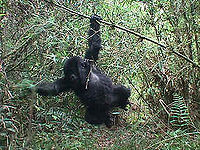- Conservation in Uganda
-
Conservation in Uganda since 1957 has involved both foreign and national agencies.
Wildlife Conservation Society began conservation work in Uganda through conducting biological surveys of savanna parks in 1957 . Since then WCS has continued to provide funds for conservation almost every year up to the present despite the era of Idi Amin and the civil wars that followed.
During the 1970s and 80s, they supported conservation of Kibale Forest, which became a national park in 1993 . WCS has supported the building of research and management capacities of Ugandans through aiding student research projects, helping to develop the Institute of Tropical Forest Conservation (ITFC), and more recently providing training to the Uganda Wildlife Authority (UWA) and National Forest Authority (NWA) staff.
Contents
Inhibitions
The major threats to protected areas include poaching for bushmeat, illegal timber harvesting, charcoal burning and encroachment for farmland. Each of these has degraded protected areas over the past 40 years and led to reduced numbers of wildlife. Better protection in the 1990s has led to a slow but steady increase in many large mammal numbers, but some continue to decline.
WCS activities
WCS is currently supporting projects that build the capacity of Ugandan protected area managers. Working with the Uganda Wildlife Authority (UWA) they have developed a monitoring and research plan for every national park and wildlife reserve in Uganda. Wardens assess the effectiveness of their actions and how they can adapt to changes as they appear.
A census of the mountain gorilla populations over the last two years have shown increases in the numbers both in Bwindi (320) and the Virungas (380), bringing the total world population to just 700. Zoning of the forests is necessary so that fewer valuable areas can be accessed by local people for firewood, medicinal plants and other non-timber forest products. WCS also supports the Institute of Tropical Forest Conservation (ITFC) to undertake applied research on mountain gorilla conservation challenges, the effects of hard edges on long-term viability of forest islands, and the effectiveness of conservation strategies involving local people.
National parks
- Bwindi Impenetrable National Park
- Kibale National Park
- Kidepo Valley National Park
- Lake Mburo National Park
- Mgahinga Gorilla National Park
- Mount Elgon National Park
- Murchison Falls National Park
- Queen Elizabeth National Park
- Rwenzori Mountains National Park
- Semuliki National Park
External links and sources
Conservation in Africa Sovereign
states- Algeria
- Angola
- Benin
- Botswana
- Burkina Faso
- Burundi
- Cameroon
- Cape Verde
- Central African Republic
- Chad
- Comoros
- Democratic Republic of the Congo
- Republic of the Congo
- Côte d'Ivoire (Ivory Coast)
- Djibouti
- Egypt
- Equatorial Guinea
- Eritrea
- Ethiopia
- Gabon
- The Gambia
- Ghana
- Guinea
- Guinea-Bissau
- Kenya
- Lesotho
- Liberia
- Libya
- Madagascar
- Malawi
- Mali
- Mauritania
- Mauritius
- Morocco
- Mozambique
- Namibia
- Niger
- Nigeria
- Rwanda
- São Tomé and Príncipe
- Senegal
- Seychelles
- Sierra Leone
- Somalia
- South Africa
- South Sudan
- Sudan
- Swaziland
- Tanzania
- Togo
- Tunisia
- Uganda
- Zambia
- Zimbabwe
States with limited
recognition- Sahrawi Arab Democratic Republic
- Somaliland
Dependencies and
other territories- Canary Islands / Ceuta / Melilla / Plazas de soberanía (Spain)
- Madeira (Portugal)
- Mayotte / Réunion (France)
- Saint Helena / Ascension Island / Tristan da Cunha (United Kingdom)
- Western Sahara
Categories:
Wikimedia Foundation. 2010.

